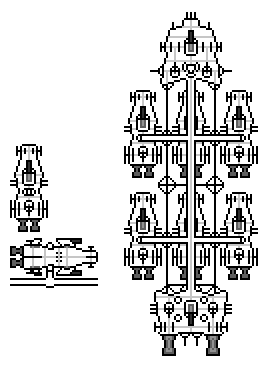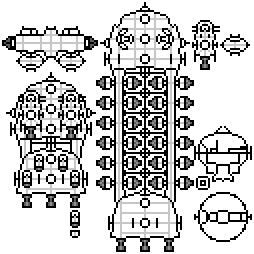When the directory of vehicles expands to an unwieldy size, its images will be broken up into categories. Until then, however....
A list of propulsion methods for spacecraft.
A list of passive defense methods for spacecraft.

Standard Ecumenical Blueprints #24d2 and #21a2: the Destroyer Tender and the Destroyer. These are two of the most-used military spacecraft designs in the modern Ecumene, and examples are available in a myriad of forms and designs- these are largely idealized specimens, actually built for the purpose of war reenactment, but similar designs are (and were) commonly in use. Destroyers most commonly operate in squadrons of between three and eighteen vessels, and are designed for escort duty or for attacking similarly-sized spacecraft rather than fighters or larger spacecraft. Destroyer tenders operate as long-ranged transport and combined supply for destroyer squadrons (this example can support between three and twelve destroyers, but is optimized for six), providing not only fuel and munitions but also food and recreation. Because of the latter property, destroyer tenders are often named (formally or informally) with food-related terms; and because destroyer squadrons are named after the tender they operate from it's common to encounter a destroyer designated along the lines of "Succulent #6".

Standard Ecumenical Blueprints #25a5 and #25a0: The Express Ship and the Express Boat. The Express Ship serves as a tender for Express Boats, but its main role is actually the delivery of important cargo- hence the many docking ports on its surface. Its extremely important secondary role is to serve as a place for refueling Express Boats and providing their pilots a place to socialize and rest. Express Boats are in effect a small (twenty-eight square metres) apartment for their pilots, with the X axis of the spacecraft containing sleeping and working spaces. A small fresher, closet, and kitchen are located on one side, with the rest of the pressurized volume free to decorate as the pilot wishes. The rest of the spacecraft is, from top to bottom- an extensible docking tube with built-in ladder, wing drives, computer, fuel, twin impellers, and a miniaturized high-speed vault drive. An Express Boat usually belongs to a single pilot for at least 330 days per year- enough time to traverse the Hydric Main going one way, with 44 full days of time aboard Express Ships- before the pilot must take a vacation. The job of an Express Boat pilot does not often require undivided attention, but may require a lot of training for the times when undivided attention is needed. This Express Ship is shown with twenty-four Express Boats, its full long-term complement (though it can tug up to forty-eight attached to it). It is also shown with two #25c1 Patrol Corvettes, capable of acting as escorts or as transfer shuttles; and four #26x0 mini-launches, with modular parts allowing for cargo, ferry, or mail shuttle duty.

This is a Lupastrid displaying various features common to Lupastrids. Note the two halves- one has all protrusions extended, the other with all protrusions sheathed. Note as well their variegated coloration- either displaying a complex mix of emotions, or simply for aesthetic value. This shipself format is fairly common with Lupastrids native to the inner Ecumene- some Lupastrids even have habitable internal volumes.
The Ecumene has a Standard Blueprints Catalog, with each designation corresponding to a set of laws and designs that lay out a fully-functional design for a vehicle or device. The designation system is complex, but is decipherable:
Each digit can be a number or extended to a letter if necessary. Standard designations are usually eight digits, but can be shortened to three to convey a general concept.
In many fictional universes and several real-life instances, FTL drives take up large portions of spacecraft but antigravity propulsion is commonplace- in the Ecumene, FTL drives are commonplace but antigravity propulsion is bulky. As such, most spacecraft in the Ecumene are largely unstreamlined with only skimming of gas giants for fuel as a consideration- and as consequence most interstellar travel infrastructure is established in orbit rather than on the surface of planets. Scouting spacecraft, on the other hand, are generally designed with full-speed atmospheric entry in mind and often include lifting surfaces. As such, where local naval and scouting bases need to share the same planet the naval base is most often a highport while the scouting base is a lowport.
Warships, needing various permanent protruberances for weaponry, are often streamlined only in general shape- a three-dimensional wedge or trapezoid. This facilitates emergency wilderness foraging and refueling. Replenishment and resupply ships, on the other hand, have much less weaponry and need to be able to obtain fuel from diverse sources. As such, these craft are often full-on lifting bodies or aircraft- and are often nicknamed by their crews along the lines of "the flying shoe".
On the other side of the equation are antigravity-driven surface-to-orbit spacecraft. These are uncommon in the Ecumene, but many polities have more refined gravitic technology and made good use of them. However, they are the perfect ingredient in a mass transit system- instead of distasteful orbital rings, high-pollution chemical rockets, concerning-for-passengers ground laser arrays, or a full investment in proper interplanetary shuttles; a large G-Shuttle vehicle can be used to ferry hundreds to disparate orbits in about as much time as it would take for a high-speed train to travel twice the distance.
The main downside of G-Shuttles is that they can only travel up to one location before needing to come back down- it's already hard enough getting the gravitics to let it slow itself down, so travelling between space stations or similar destinations is near-impossible. As previously mentioned, G-Shuttles also have very limited range- at the lowest, a G-Shuttle would only be able to reach very low orbits around low-mass thick-atmosphere worlds; while at the highest G-Shuttles can do "interplanetary" work in a gas giant or brown dwarf's local system. G-Shuttles also find "interplanetary" duty at binary planets, and in ersatz-interplanetary work they are often outfitted more like long-haul liners than shuttles- some even rival true interstellar liners in size, because their planetary drives simply aren't built for quick trans-orbital journeys. The longest G-Shuttle haul on record is a two hundred day cargo journey across the 2.4 million kilometre gulf between two planets, each about 70 times heavier than a standard habitable world, that orbited each other in just two months.
G-Shuttles are odd to build, owing to their rather different design principles. As a result they are impractical to build from conventional spacecraft.... but they are extremely easy to convert into conventional spacecraft, especially if one wishes to leave the ace up the sleeve of easy planetary landing capability. Former long-haul G-Shuttles have found themselves in roles both similar to their original roles and completely different- some now exist as auxilliary military and diplomat transport vessels, some serve as tanker craft for large spacecraft, and some of the largest have even been converted into proper exploratory starcraft.
System monitors are spacecraft that have an FTL drive specialized for high speeds but short ranges, which means they can provide quite efficient denial against more proper warships. Because they are never more than a couple days from port- even in a sparse large system with their ftl drives and inertiics blown out- they skimp on consumables and living space. As such, more of that space can go to weapons, reactors, engines, and ammo reserves. One option for monitors that is taken often is remote control from a command monitor. The oversized ammo reserves of monitors means they explode in a significantly more spectacular manner than conventional craft of the same size.
Spacecraft in the Ecumene can reach unwalkable sizes very easily, even for those spacecraft that minimize their cross-section on one axis. Likewise, there are points where bulk materials or even vehicles must be transferred from one point to another and more standard pipe systems will not suffice. Because of these reasons, most large spacecraft in the Ecumene have internal transit systems. The standard for these systems is often a derivative of the systems used for transit in particularly large arcology concepts- a hybrid between an elevator and a train. Usually, these transit networks consist of what some call a tree system- so named because in a cone-shaped ship it consists of branches springing from a central vertical trunk.
The Miraculide series of elements is a misnomer- while materials touted as miraculides are occasionally unique elements, they are more commonly isotopes, isomers, allotropes, or even plain alloys and compounds. Likewise, there is no definite series of miraculides- they have extremely variant physical qualities, and a full listing based on these qualities would necessarily include thousands of other materials. Nevertheless, miraculides are often the discovery that makes a society gain interstellar capability. The first miraculide discovered is often verdicium, an alumium superatom that when used in a properly constructed collector can make interstellar ramjets functional even in highly rarefied interstellar conditions. If not verdicium, it's often trifluoric- a compound of mercury and fluorine that, while extremely dangerous to make, is a high-efficiency nontoxic storable rocket fuel. There are as many natural miraculides (such as duranium and dilithium) as synthetic ones- some lucky life even arises on worlds suffused with miraculides. While maintaining an interstellar civilization often becomes easier with miraculides, limited supply can mean that a civilization will elect to not use miraculides at all and get along just as well.
Trans-Hyperborica and its military- this page has a lot of ship details.
Bio-engineering and habitability acclimatization.
A list of superclass names for starcraft.